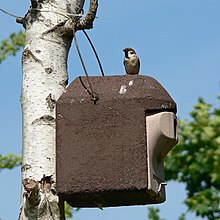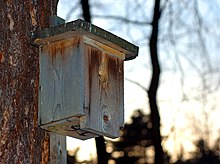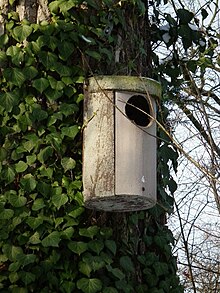nesting box
A nest box is the classic form of a man-made nesting aid .

purpose
Nest boxes have a cavity that can be used by certain animal species to raise their brood and young animals as well as for overnight purposes. Above all, they serve to protect species, especially birds ( cave breeders , niche breeders ), mammals ( bats , dormice ) and insects ( bees , bumblebees , hornets , wasps ).
In forestry and fruit growing , the settlement of insect-devouring cave- and niche-breeding songbirds with nesting boxes is a measure to counteract the prevalence of pest caterpillars and thus to avoid the ecologically problematic use of insecticides .
Types, construction and nature
For many decades, nest boxes have been constructed very differently, depending on which species of animal is to be settled and which building material has been used.
For birds

In bird nesting boxes, the size of the breeding space and the diameter of the entrance hole exclude some species. While the standard width of the entrance hole for small birds is 30 to 34 mm or oval 30 by 45 mm (e.g. nuthatch , great tit , pied flycatcher , sparrow ), with an entrance hole width of 26 to 27 mm almost only blue , swamp , Willow , fir and crested tits in the nesting aid. The star , on the other hand, needs a somewhat larger brood space and an entrance hole 45 mm in diameter. The volume of the interior space below the entrance hole should generally be at least 1600 cm³.
The light conditions inside the nesting box can also prevent certain species from building their nests there. This applies, for example, to niche breeding birds that love brightness. Although these bird species (e.g. robins , black redstart , white wagtail , gray flycatcher ) also often adopt so - called half - caves , the broods in these nesting devices, which are half open at the front, almost always fall victim to nest robbers .
For cave and niche breeders
The best known and most widespread nest boxes are those for cave and niche breeders among birds.
To a certain extent, the original form of these nest boxes are so-called nest boxes . This form of nesting aid goes back to the Thuringian ornithologist Hans Freiherr von Berlepsch (1857–1933). Based on the model of the natural woodpecker caves , which are one of the most important homesteads for cave breeders in the near-natural forest, Berlepsch developed a type of nesting cave made of trunks of the black alder in several sizes adapted to different bird species. These Berlep nest boxes , which were the first to be machine-made in series, gave the idea of bird protection a great boost.
Safe niche nesting boxes with two oval entry holes of around 32 by 50 mm guarantee a much greater breeding success with a generally slightly lower acceptance.
Conventional, angular cave and niche nesting boxes are traditionally made from wooden boards (see illustration), while round nesting boxes are made from logs.
With wooden nesting devices, the same disadvantages always reveal themselves in the medium term. On the one hand, there is the susceptibility of the wood to weathering , which among other things leads to fungal attack and thus to faster wood rot ; on the other hand can woodpecker and squirrels chiselling the nest boxes or aufnagen and get to the bird breeds.
In the last few decades, the most suitable nesting devices have proven to be those that are industrially manufactured from a durable, resistant mixture of cement and coarse sawdust , so-called wood concrete . These nesting devices, first manufactured in the late 1950s, have been developed in various designs over time that take into account the needs of certain bird species and protection against nest predators. Nesting devices made of wood-concrete are produced and sold in Germany by several specialist companies for bird protection products.

For tunnel or tube breeders
There are nesting aids for kingfishers and sand martins with a tubular 20 to 30 cm long entrance, which accommodates the breeding behavior of these species. Other bird species that are also funded with nesting boxes, which are designed to their specific needs through are, for example, gardening and Waldbaumläufer , dippers , swifts , Dove , Common Goldeneye , Common Merganser , Kestrel , Peregrine Falcon and almost all species of owls. With the exception of the short-eared owl, all breeding owls in Central Europe breed in nesting boxes, with the long-eared owl only going in half-cave boxes . Eagle owls only rarely breed in nest boxes, but more often on open nesting platforms.
For free brooders
The wren is the only bird species in Central Europe that appears both as a free breeder and as a cave and niche breeder. Based on the model of his nest, a spherical nesting aid was developed especially for the wren.
For pet birds
Nest boxes for ornamental birds are commercially available for aviaries. Like many nest boxes and nest boxes for outdoor use, they are also made of wood, clay or plastic. Since ornamental birds can hardly find any nest-building material in their cages, an integrated nest is also available as an accessory .
Orientation, protection, maintenance and care
Nest boxes must be oriented to the east, away from the weather. The box will never be accepted if the entry hole is towards the west.
In addition to the durability and resilience of the material from which the nesting boxes are made, the protection of broods and young animals must be guaranteed primarily by the construction.
Nesting boxes equipped with marten protection usually have a drawn-out entrance hole, which prevents the tree or stone marten from being able to reach the broods with their paws through the entrance hole.
The long-term effectiveness of an organic odor deterring the marten, which is added to special nesting devices, is, however, controversial.
To prevent cats from climbing up trees with nesting boxes on them, bird conservationists sometimes use a so-called cat defense belt , a metal halo that is attached about one meter above the ground, during the breeding season .
It goes without saying that any disturbances to the nesting boxes should be completely avoided or at least kept as low as possible during the breeding and rearing times. This should already be considered when selecting suitable locations.
It is also extremely important that nesting devices are out of the reach of unauthorized persons. In areas that are not supervised further ( forests , parks , cemeteries , etc.), they should therefore be installed at a height of at least four meters if possible. In the case of the suspension device, it is also important to ensure that the nest boxes cannot be poked down. In the case of a wooden suspension device, it is important to ensure that the associated nail is not hammered in all the way to the head, otherwise the growth of the tree will soon cause the device to burst.
For the durability of all nesting boxes that are attached to trees and for the thriving of the broods and bat nurseries in them , hanging on the side facing away from the weather can be decisive. The orientation of the entrance hole towards the southeast has proven itself over time.
Tree species whose bark radiates a lot of moisture or has a strong tendency to overrun by foreign bodies (e.g. red beech , poplar , ash , birch , younger maple , younger linden ) are not recommended for nailing nest boxes directly to the trunk.
Finally, regular maintenance of the nesting boxes is essential (cleaning the interior, checking the overall condition and the hanging device, reassessing the hanging location). Such a so-called nest box control should ideally be carried out annually, but at least every two years from September to November.
See also
Birdhouses , nesting aids , cave breeders , niche breeders , bird protection , bat boxes
literature
- Hans-Werner Bastian: Self-made nesting boxes suitable for birds . Franckh-Kosmos Verlag, 2000, ISBN 3-440-08103-6
- Hans Freiherr von Berlepsch : The entire bird protection. Its justification and execution on a scientific, natural basis . 12th edition. Neudamm: Neumann 1929
- Gerhard Föhr: Nest boxes and bird protection through the ages . The new Brehm library (volume 651). Westarp Sciences, Hohenwarsleben 2005, 91 pages, ISBN 3-89432-909-2
- Eberhard Gabler: Nest boxes and bird feeders. Building instructions and practical tips . BlV Verlagsgesellschaft, Munich 2003, ISBN 3-405-16489-3
- Otto Henze , Günther Zimmermann: Feathered friends in the garden and forest. Observe - Recognize - Protect. Munich: Bayerischer Landwirtschaftsverlag (BLV) 1964
- Otto Henze (founder), Johannes Gepp: Bird nest boxes and natural caves in the garden, forest and area. Identification book nests & clutches . 6th edition Leopold Stocker Verlag , Graz and Stuttgart 2004, ISBN 3-7020-0992-2
- Klaus Richarz, Martin Hormann: Just build it yourself. Species-appropriate nesting and feeding houses for domestic birds. Aula-Verlag, Wiebelsheim 2013, ISBN 978-3-89104-754-5
Individual evidence
- ↑ Klaus Richarz / Martin Hormann, Simply build it yourself , Wiebelsheim 2013, p. 15.
- ↑ Planning and production were scientifically accompanied even then; see e.g. B. Herbert Bruns : Investigations into the acceptance of nesting devices with and without marten protection device by cave-breeding songbirds , special edition from: Ornithologische Mitteilungen, year 9, 1957, pp. 24-26
- ↑ Martin Lindner: The eagle owl ( Bubo bubo ) as a building breeder - with comparison to the peregrine falcon ( Falco peregrinus ). Population ecology Birds of prey and owl species Vol. 6 2009: 411-431.
Web links
- Bund für Umwelt- und Naturschutz Deutschland / BUND, local group southern Upper Rhine - nest box info
- dto .: Nest box construction and bird protection for children
- Information and building instructions from the State Association for Bird Protection
- Instructions for self-construction of nesting boxes and nesting aids for birds (from Naturschutzbund Deutschland / NABU )
- Private "Nest Box and Bird Protection Museum" , accessed on May 24, 2010, 2:41 pm CEST




